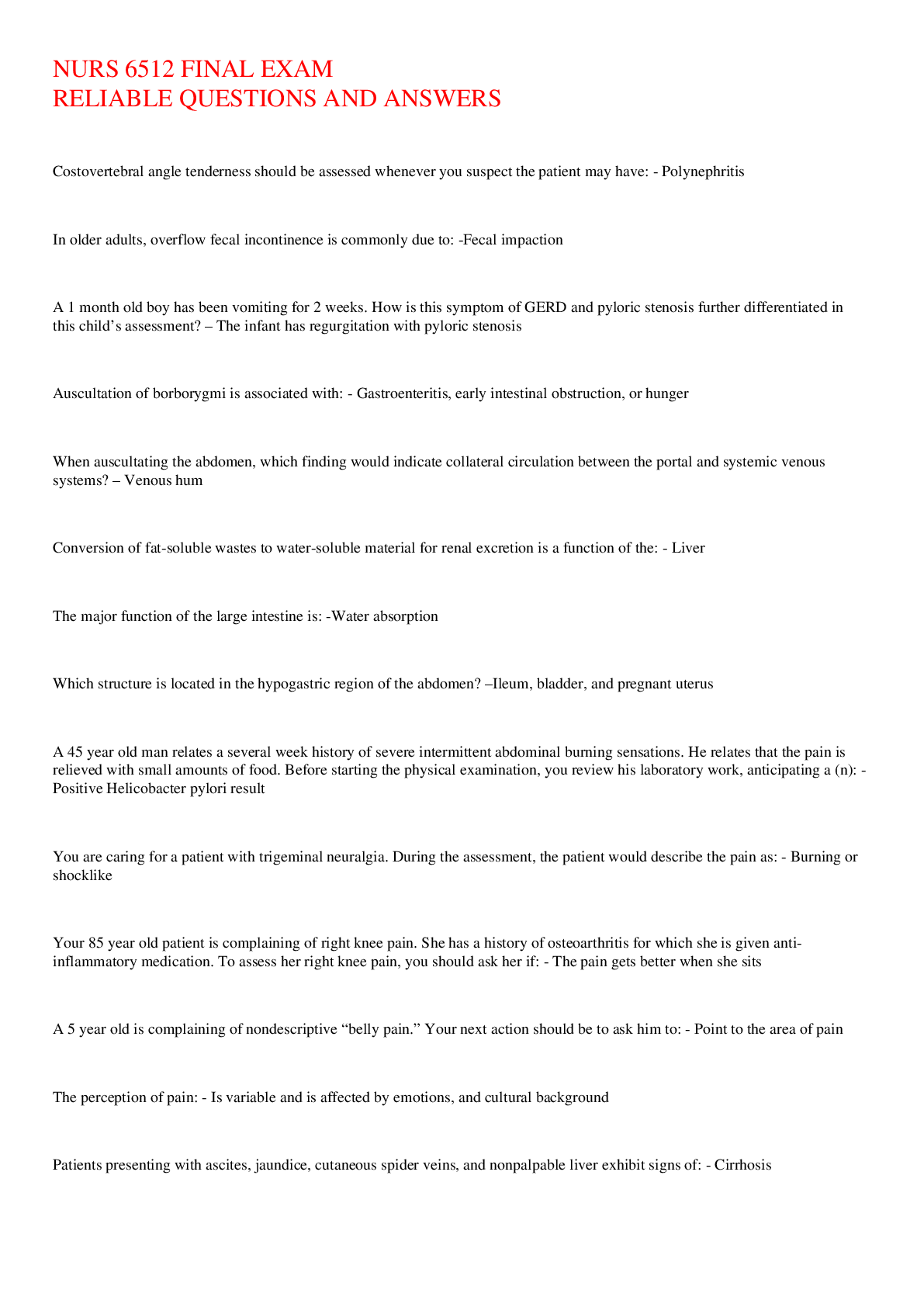Leadership > EXAM > Huber: Leadership & Nursing Care Management, 6th Edition Exam 2 Unit 4-6 Question And Answers( Rated (All)
Huber: Leadership & Nursing Care Management, 6th Edition Exam 2 Unit 4-6 Question And Answers( Rated A)
Document Content and Description Below
Exam 2 Unit 4-6 Chapter 04: Managerial Decision Making Huber: Leadership & Nursing Care Management, 6th Edition MULTIPLE CHOICE 1. What is the definition of the process of making choices that will pro... vide maximum benefit? a. Critical thinking b. Problem solving c. Decision making d. Leading ANS: C Decision making is the process of making choices that will provide maximum benefits. DIF: Cognitive Level: Remember (Knowledge) TOP: Nursing Process: Assessment MSC: Client Needs: Safe and Effective Care Environment: Management of Care 2. A patient has arrived at the critical care unit with a head injury. On admission, the patient is talking and is a little drowsy but oriented. Two hours later, the nurse discovers that the patient is talking at a rapid pace and keeps repeating his words. When the nurse recognizes the change and deploys the rapid response team and physician, which skill is being demonstrated? a. Leadership b. Clinical judgment c. Clinical decision making d. Management ANS: B The competent nurse uses the information about head injury, change in mental status from talking and drowsy but oriented to talking at a rapid pace, and the potential for the patient to deteriorate to discern that the patient is experiencing cerebral edema or increased intracranial pressure. The nurse is demonstrating clinical judgment, which is the interpretation of the information of patient problems and needs. DIF: Cognitive Level: Analyze (Analysis) TOP: Nursing Process: Assessment MSC: Client Needs: Safe and Effective Care Environment: Management of Care 3. Which of these concepts is key to refining clinical judgment capabilities? a. Critical judgment b. Reflection c. Management experience d. Nursing expertise ANS: B Reflection is key to refining the capabilities of clinical judgment. As a nurse gets more experience, the intuitive component of judgment follows. Nurses do not require management experience or nursing expertise to refine clinical judgment. DIF: Cognitive Level: Remember (Knowledge) TOP: Nursing Process: Assessment MSC: Client Needs: Safe and Effective Care Environment: Management of Care 4. A staff RN is leading a quality improvement team on the care of the total hip replacement patient. The issue is an increased length of stay from 1 year ago. The nurse asks team members to reframe the problem statement from their perspective. Twenty different problem statements were developed. The team is focusing on four of the problem statements. This is an example of which of the following techniques? a. Decision making b. Evaluating the consequences c. Inclusive judgment d. Problem processing ANS: A Decisions are made following the basic problem-solving process but also involve an evaluation of the effectiveness of outcomes that result from the decision-making process itself. DIF: Cognitive Level: Apply (Application) TOP: Nursing Process: Planning MSC: Client Needs: Safe and Effective Care Environment: Management of Care 5. How is decision making at the staff nurse level exemplified? a. The staff nurse adapts to a challenging patient assignment. b. The staff nurse refers issues to the performance improvement committee. c. The staff nurse accepts the status quo. d. The staff nurse questions current practice and refers to unit leadership for change. ANS: A Decision making is the process of making choices from several courses of action in order to solve problems. The process of selecting one course of action from alternatives forms the basic core of the definition of decision making. The staff nurse who adapts to a challenging patient assignment is using decision making to affect the quality of patient care delivered. DIF: Cognitive Level: Apply (Application) TOP: Nursing Process: Assessment MSC: Client Needs: Safe and Effective Care Environment: Management of Care 6. What is the final step in the clinical reasoning process? a. The right cues b. The right patient c. The right reason d. The right time ANS: C There are five steps for clinical reasoning, which involves five rights: the right cues or clinical data, the right patient or setting priorities, the right time or capability of identifying high risk patients, the right action or clinical decision that results from the clinical reasoning process, and the right reason. The right reason incorporates legal and ethical considerations. DIF: Cognitive Level: Remember (Knowledge) TOP: Nursing Process: Assessment MSC: Client Needs: Safe and Effective Care Environment: Management of Care 7. A nurse manager has ordered equipment for a new unit. The company has sent two notices that the equipment is on back order. The nurse manager is debating whether to wait for the equipment on back order or to cancel the order and go with another company. She discusses this issue with another nurse manager and they determine that the equipment is urgent for patient safety in the new unit. The manager orders the necessary equipment from another company even though it is slightly more expensive. This is an example of: a. clinical decision making b. prioritization c. triage decision d. clinical reasoning ANS: B Prioritization occurs not only in triage situations, but also across the care spectrum. Thus decisions have to be made regarding what care has to be delivered and when the care is to be delivered. All nurse managers and leaders need to consider the implications of their decisions. Each decision made involves financial, ethical, and human resources. Furthermore, reimbursement and other regulations must be taken into account. DIF: Cognitive Level: Apply (Application) TOP: Nursing Process: Assessment MSC: Client Needs: Safe and Effective Care Environment: Management of Care 8. The nurse in a medical-surgical unit is working short-staffed due to a sick call. Which of these is an example of prioritization? a. Charting by exception b. Omitting personal hygiene in favor of timely medication administration c. Timely medication administration without scanning the patient armband d. Deploying a rapid response team when a patient condition changes ANS: B Prioritization occurs not only in triage situations, but also across the care spectrum. Thus decisions have to be made regarding what care has to be delivered and when the care is to be delivered. For example, nurses implicitly make decisions to ration care when time and staffing are short (Jones, 2015). On a day-to-day basis nurses must decide if such things as routine hygiene activities are omitted in favor of administering critical treatments, including medications DIF: Cognitive Level: Analyze (Analysis) TOP: Nursing Process: Assessment MSC: Client Needs: Safe and Effective Care Environment: Management of Care 9. A family member of a patient files a complaint that her mother’s dentures were lost when the patient was transferred from one unit to another. The risk management department interviews the patient and the staff nurses who cared for the patient. Which of the following problem-solving techniques was used? a. Delegation b. Direct intervention c. Indirect intervention d. Purposeful inaction ANS: B The focus of leadership and management decision making is more closely related to the nurse’s role as care coordinator and systems problem solver. Some decisions, such as those requiring disciplinary action, do require the manager’s direct intervention. DIF: Cognitive Level: Apply (Application) TOP: Nursing Process: Assessment MSC: Client Needs: Physiological Integrity: Basic Care and Comfort 10. Which of the following scenarios is an example of clinical reasoning? a. A nurse ignores a client’s requests to stop his dialysis. b. A nurse is scheduled to work over the weekend, and she has a family outing to attend. c. A nurse is counseling a woman with breast cancer about terminating her pregnancy and receiving chemotherapy or completing the pregnancy and possibly not surviving. d. A nurse has been offered an exciting new position with a dramatic increase in salary, but she would have to move out of state, away from her ailing parents. ANS: C Clinical reasoning is the process of analyzing and synthesizing both objective and subjective cues about patients. Levett-Jones and colleagues (2010) defined five steps for clinical reasoning. They stated that clinical reasoning involved five rights: the right cues or clinical data, the right patient or setting priorities, the right time or capability of identifying high risk patients, the right action or clinical decision that results from the clinical reasoning process, and the right reason. The right reason incorporates legal and ethical considerations. For example, the clinical process may lead a nurse to recommend that a patient needs respiratory support in the form of a ventilator. However, the patient may have an advance directive that would cause the clinician to make a different decision. DIF: Cognitive Level: Analyze (Analysis) TOP: Nursing Process: Assessment MSC: Client Needs: Safe and Effective Care Environment: Management of Care 11. Nurses working on the intermediate care unit have had many hours of overtime in the last 6 months. Before forming a team, the nurse manager gathers data about patient condition severity, staffing ratios, educational levels of staff, and personality mixes on each shift. What level of decision making is this process? a. Establishment of solution evaluation criteria b. Evaluation of the alternative solutions c. Identification of a problem, issue, or situation d. Search for alternative solutions or actions ANS: C Data should be collected to identify properly the actual problem, issue, or situation. The five core elements to decision making are the following: (1) identification of a problem, issue, or situation; (2) establishment of the criteria to be used to evaluate potential solutions; (3) search for alternative solution or actions; (4) evaluation of the alternative; and (5) selection of a specific alternative. DIF: Cognitive Level: Apply (Application) TOP: Nursing Process: Assessment MSC: Client Needs: Safe and Effective Care Environment: Management of Care 12. How is SBAR used in decision making? a. Prevents cognitive errors b. Data management tool c. Financial tool d. Effective communication technique ANS: D SBAR is a communication technique that helps members of the health team communicate effectively so that appropriate decisions can be made. Because hands-off communication is so crucial to decision making about patient care, SBAR is used to clarify and organize essential but complex patient care information. DIF: Cognitive Level: Apply (Application) TOP: Nursing Process: Planning MSC: Client Needs: Safe and Effective Care Environment: Management of Care 13. The nursing education department is revising its orientation curriculum for nurse externs. The curriculum includes a module on clinical reasoning skills. What is the expected time frame for mastery of clinical reasoning? a. Nurse externs should master clinical reasoning within 6 months. b. Clinical reasoning is mastered in nursing school. c. Clinical reasoning is never mastered. d. Clinical reasoning is a career-long process. ANS: D Clinical reasoning is a career-long development process. This process must carry over from skills learned during a nurse’s education to the workplace. Nurse residency programs are one way to help newly licensed nurses develop their clinical decision-making abilities. DIF: Cognitive Level: Apply (Application) TOP: Nursing Process: Assessment MSC: Client Needs: Safe and Effective Care Environment: Management of Care 14. The decision support department has been asked to create balanced scorecards for each nursing unit. Nurse managers work with decision support on the data elements which will be useful in assessing financial, quality, and other measures in order to improve what? a. Staff turnover b. Organizational performance c. Physician satisfaction d. Reimbursement ANS: B Managers in particular can use the data to develop a balanced scorecard that assesses financial, quality, and other operational performance measures. This scorecard should be available to all staff so that organizational performance can improve. DIF: Cognitive Level: Apply (Application) TOP: Nursing Process: Planning MSC: Client Needs: Safe and Effective Care Environment: Management of Care 15. An intravenous infusion center is considering switching intravenous pumps to another vendor. A team of nurses is gathered to examine the benefits and uses and to conduct a cost analysis of various intravenous pumps. After thoroughly reviewing the data and piloting several intravenous pumps, the team votes to determine which pumps to use. The nurses selected the pump which provides them with the most safeguards for safe infusion delivery. Which type of decision-making tool was used in this process? a. Simulation b. Pilot project c. Data analytics d. Evidence informed ANS: D All nurses are familiar with evidence-based practice for clinical standards of practice. In the management realm, using evidence to make decisions is as important as is using evidence for clinical decisions. DIF: Cognitive Level: Apply (Application) TOP: Nursing Process: Evaluation MSC: Client Needs: Physiological Integrity: Pharmacological and Parenteral Therapies 16. A long-term care facility has been busy for several months with patients who have a very high acuity. Nurses have been working double shifts. The nurses have been given the task of determining whether they would like to implement an on-call program and determine guidelines for implementation, if most nurses believe that it is the best solution. This example depicts which type of decision-making tool? a. Pilot project b. Simulation c. Shared governance d. Data analytics ANS: C Shared governance is an organizational structure that promotes empowerment and autonomous decision making at the point of care, accountability that is shared among all parties in a decision, and organizational processes that promote an egalitarian environment in decision-making processes. DIF: Cognitive Level: Apply (Application) TOP: Nursing Process: Planning MSC: Client Needs: Safe and Effective Care Environment: Management of Care 17. A multidisciplinary team makes a decision to develop a plan for the use of thrombolytics in the emergency medical service system. Questions are asked such as, “Is the client a candidate for thrombolytic therapy? Does the client have a history of gastrointestinal bleeding? Has the client ever had a stroke? Does the client have any bleeding disorders?” Which of the following decision-making strategies would work best in this situation? a. Fishbone diagram b. Decision tree c. Flowchart d. Data analytics ANS: B Diagrams such as decision trees can be invaluable in understanding complicated alternative solutions. These diagrams are useful in assessment and problem definition and in considering the available alternatives for dealing with a problem. Once the alternative is chosen, a plan must be formulated for implementing the approach chosen. The choice implemented must be evaluated. DIF: Cognitive Level: Apply (Application) TOP: Nursing Process: Planning MSC: Client Needs: Safe and Effective Care Environment: Management of Care 18. A team consisting of preoperative, operative, and postoperative health care professionals and ancillary staff is examining the turnaround time from the preoperative area to discharge for patients having tonsillectomies. The goal is to decrease waiting times for clients. The team comes up with a solution and wants to test it on a small group of patients before rolling it out to the rest of the department. What type of decision-making tool is exhibited? a. Shared governance b. Evidence informed c. Pilot project d. Trial and error ANS: C Pilot projects are critical for implementation for evidence-informed decision making. Pilot projects or carefully defined trials are used to experiment by trying out a solution alternative on a small or restricted basis to reduce risk and to see whether major problems will occur. Pilot project strategies may resemble research projects, and these projects may also be linked to quality improvement initiatives. DIF: Cognitive Level: Understand (Comprehension) TOP: Nursing Process: Evaluation MSC: Client Needs: Safe and Effective Care Environment: Management of Care 19. Which of these clinical decisions poses the greatest risk for committing an error? a. Verifying medication dose prior to administration b. Charting by exception c. Prioritizing patient care activities d. Independent interpretation of a medication order ANS: D Medication administration involves many decisions. In order to protect the patient, the nurse must deliver medications safely while managing the environment in order to preserve safe medication administration (Dickson & Flynn, 2012). According to Dickson and Flynn’s study, medication administration involves decisions regarding managing distractions, interpreting orders, and documenting errors and near-misses. In addition, Sitterding and colleagues (2012) found that work-flow interruptions can interrupt the cognitive processes necessary for decision making. DIF: Cognitive Level: Apply (Application) TOP: Nursing Process: Planning MSC: Client Needs: Safe and Effective Care Environment: Management of Care 20. .The nurse manager is dealing with a situation between two nurses who disagree on patient assignments. The nurse manager decides to allow the two nurses to work out their differences between themselves because the patient needs and the needs of the unit are being met. After the situation is resolved, the nurse manager praises the two nurses for making autonomous decisions about staffing. What will be the likely outcome of praising the nurses in this situation? a. higher job satisfaction b. Lower job satisfaction c. Lower patient satisfaction d. Increased staff turnover ANS: A A nurse manager’s leadership style may affect how decisions are made throughout the organization. Decisions about the safety culture are a part of a nurse manager’s role. Merrill (2015) found that a transformational leadership style contributed to a positive safety culture. Praising employees affects a nurse’s job satisfaction. DIF: Cognitive Level: Remember (Knowledge) TOP: Nursing Process: Assessment MSC: Client Needs: Safe and Effective Care Environment: Management of Care 21. Effective managers utilize a wide array of data in making decision. Which of these techniques is used to build process improvement models? a. Incrementalism b. Scenario planning c. Six Sigma d. Budgetary model ANS: C Six Sigma is a quality and decision support technique that uses data to build process improvement models. The goal is to eliminate defects in safety and quality in health care delivery (American Society for Quality Improvement, n.d.). Essentially Six Sigma is a variant of the plan-do-study-act (PDSA) cycle promoted by the Institute for Healthcare Improvement. DIF: Cognitive Level: Remember (Knowledge) TOP: Nursing Process: Planning MSC: Client Needs: Safe and Effective Care Environment: Management of Care MULTIPLE RESPONSE 1. Nurse managers in patient care areas must manage staffing on a daily basis. The degree of work needed for any patient is known as nursing intensity and includes which of these other variables? (Select all that apply.)? a. Severity of illness b. Complexity of patient’s condition c. Amount of time needed with patient d. Complexity of care e. Patient’s dependency ANS: A, C, D, E The degree of work needed for any patient is called nursing intensity and is a combination of the severity of illness, the patient’s dependency, the complexity of care, and the amount of time needed. The need-severity (physical and psychological) is called patient acuity, which is a rating of the complexity of the patient’s condition. DIF: Cognitive Level: Apply (Application) TOP: Nursing Process: Planning MSC: Client Needs: Safe and Effective Care Environment: Management of Care 2. Two cognitive processes that nurses use in clinical reasoning include: (Select all that apply.) a. education. b. acuity. c. staffing ratios. d. experience. ANS: A, D Clinical reasoning is the process of analyzing and synthesizing both objective and subjective cues about patients (Johansen & O’Brien, 2015). The nurse’s level of analysis is influenced by experience and education. DIF: Cognitive Level: Analyze (Analysis) TOP: Nursing Process: Assessment MSC: Client Needs: Safe and Effective Care Environment: Management of Care 3. Utilizing the DECIDE acronym for the process of decision making, what are the first and final steps in the process? (Select all that apply.) a. Develop and implement an action plan for problem solution. b. Establish criteria for what you want to accomplish. c. Define the problem and determine why anything should be done about it. d. Evaluate the decision through monitoring, troubleshooting, and feedback. e. Determine the best choice or alternative. ANS: C, D ......................................CONTINUES [Show More]
Last updated: 1 year ago
Preview 1 out of 101 pages
Instant download
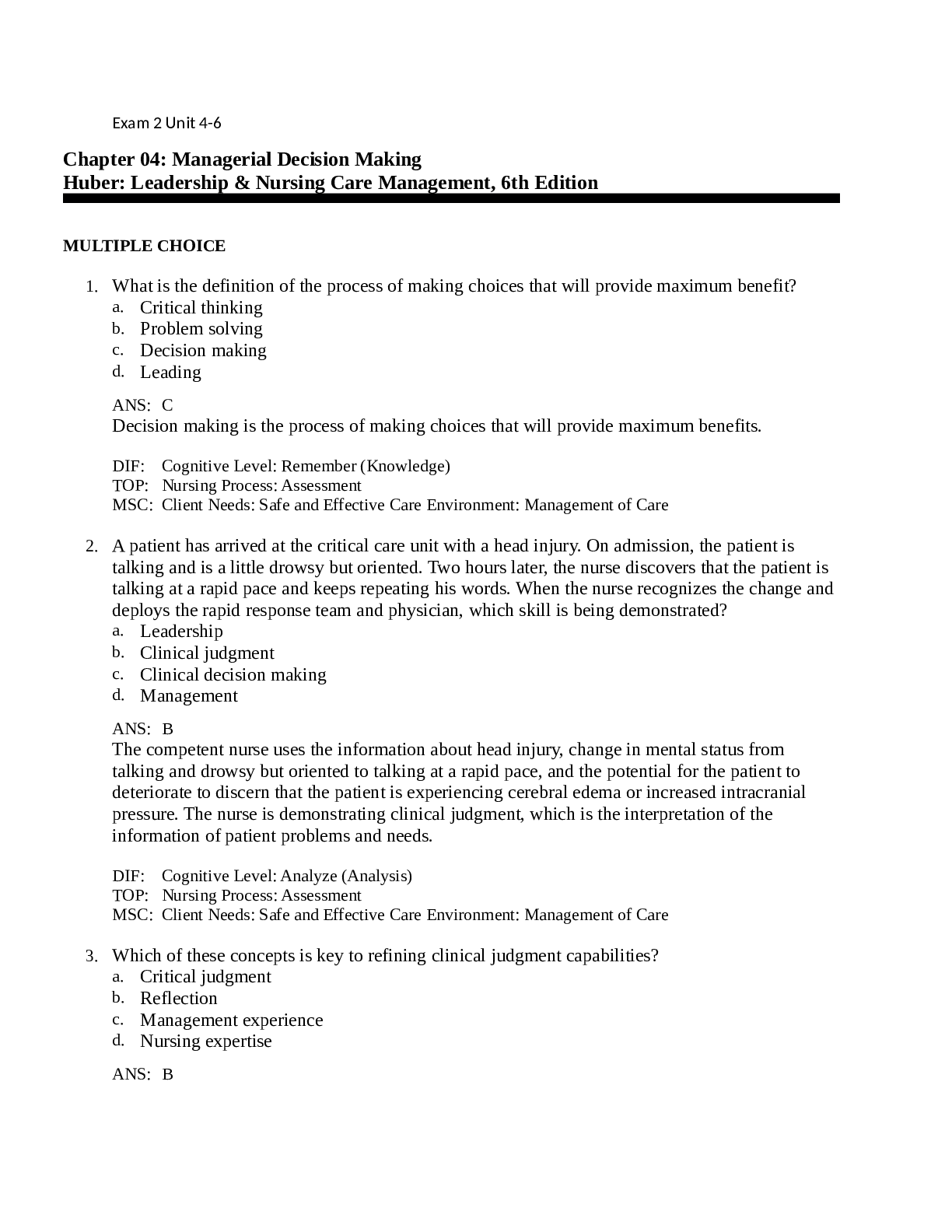
Buy this document to get the full access instantly
Instant Download Access after purchase
Add to cartInstant download
Reviews( 0 )
Document information
Connected school, study & course
About the document
Uploaded On
Feb 12, 2021
Number of pages
101
Written in
Additional information
This document has been written for:
Uploaded
Feb 12, 2021
Downloads
0
Views
57

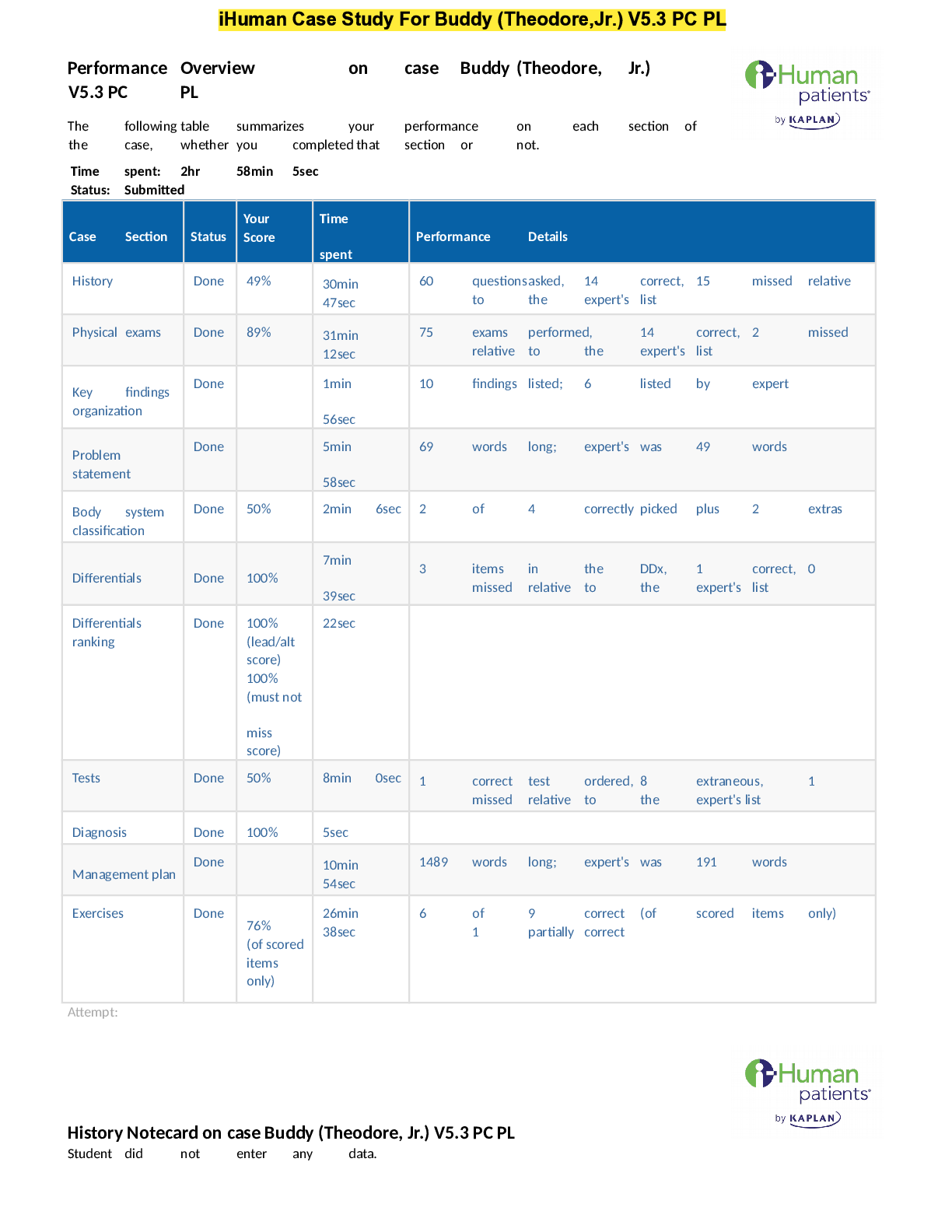
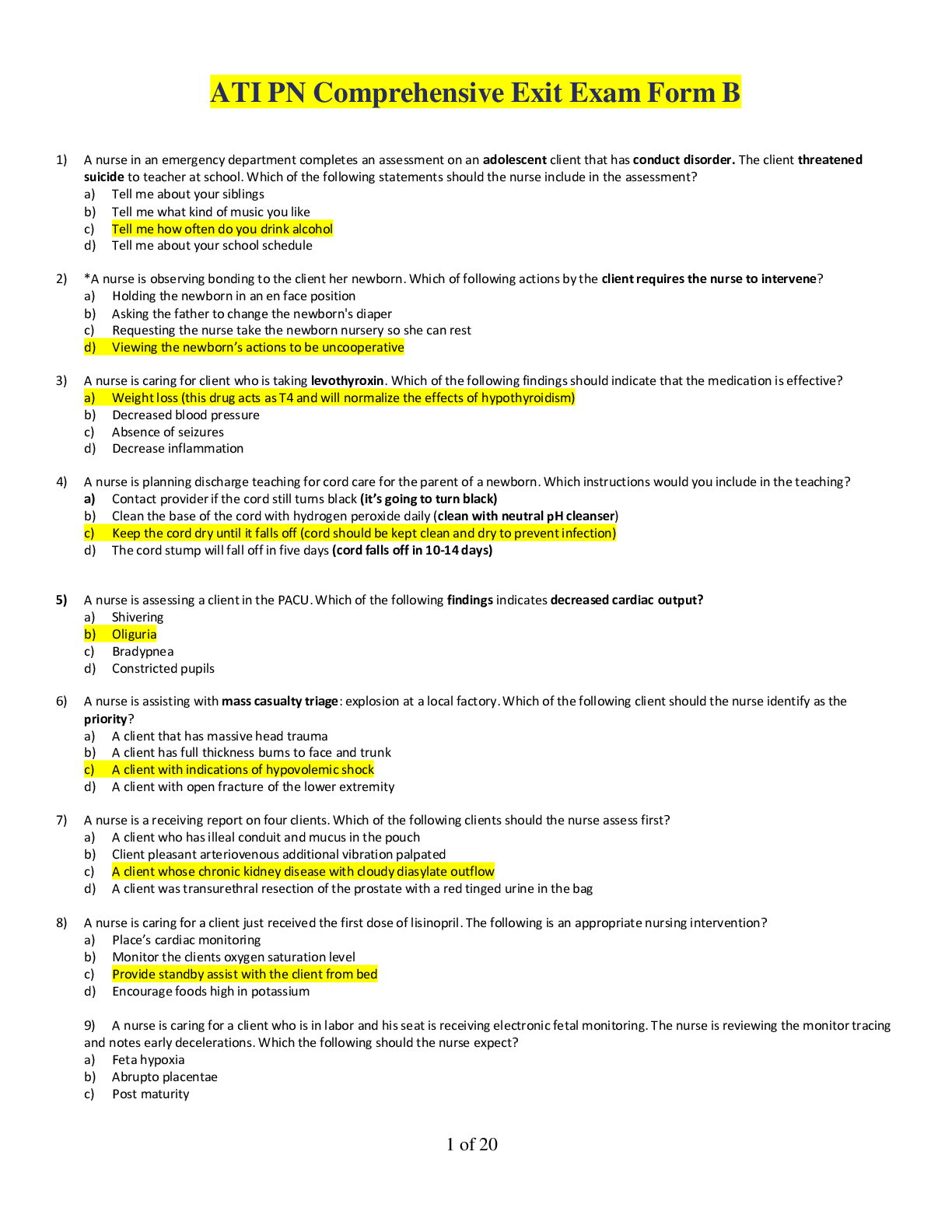
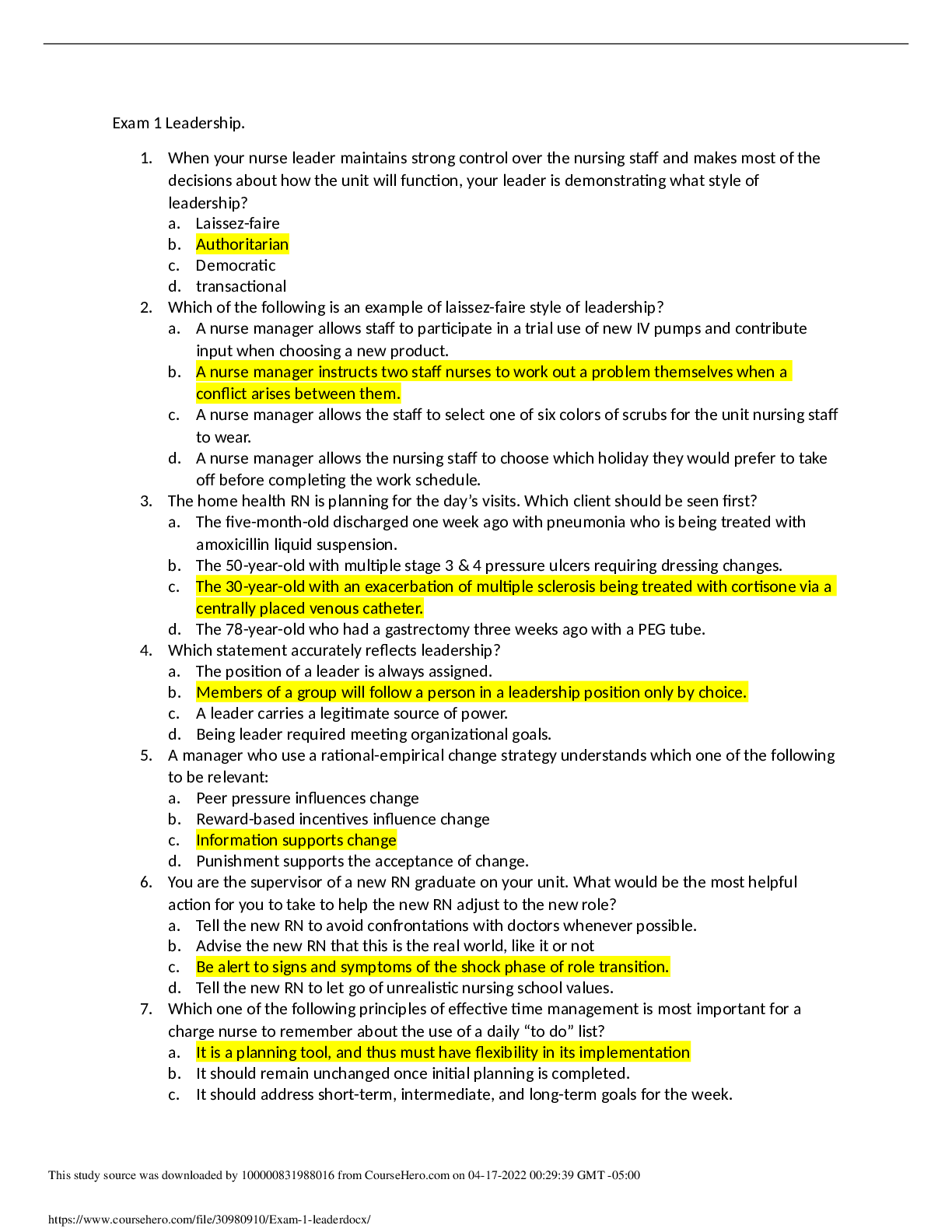


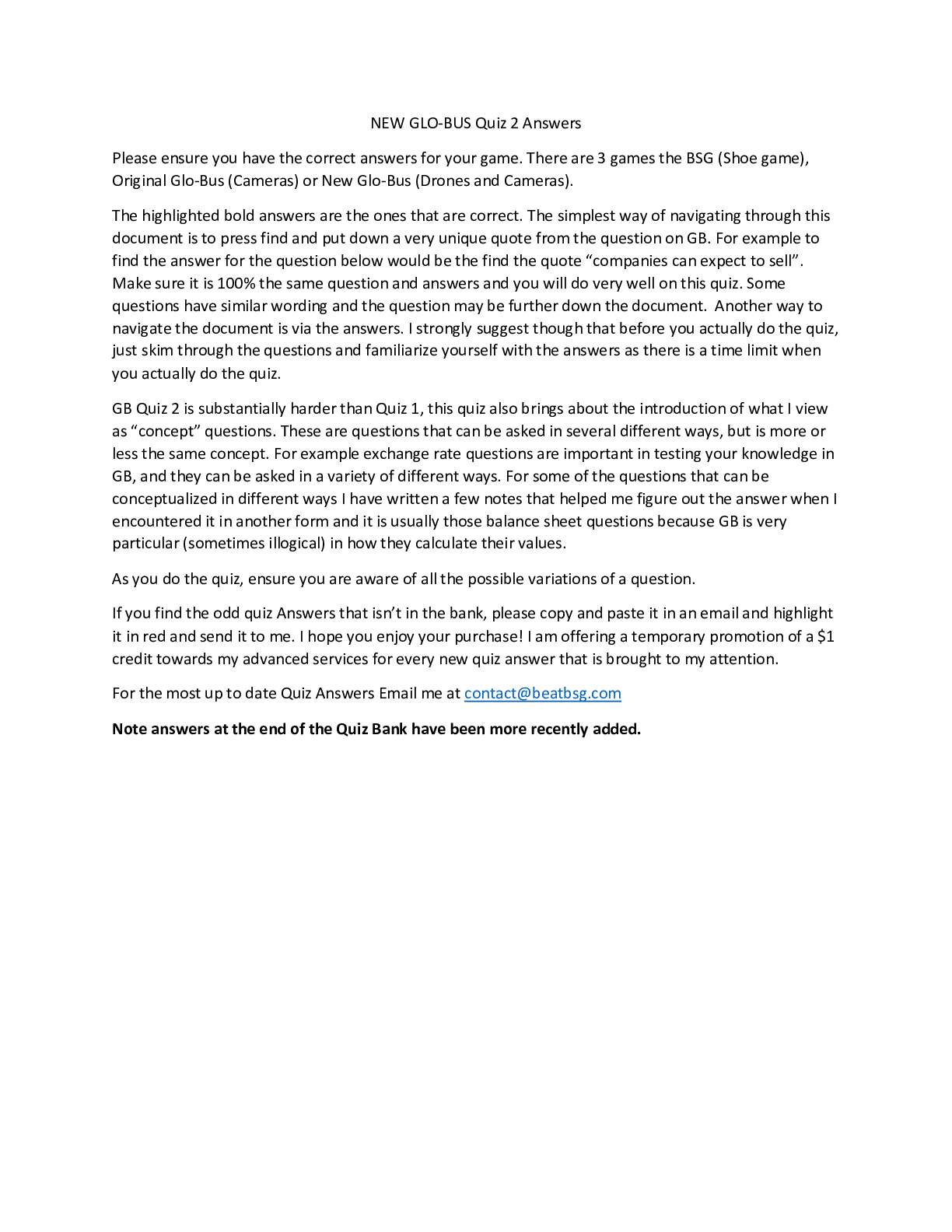
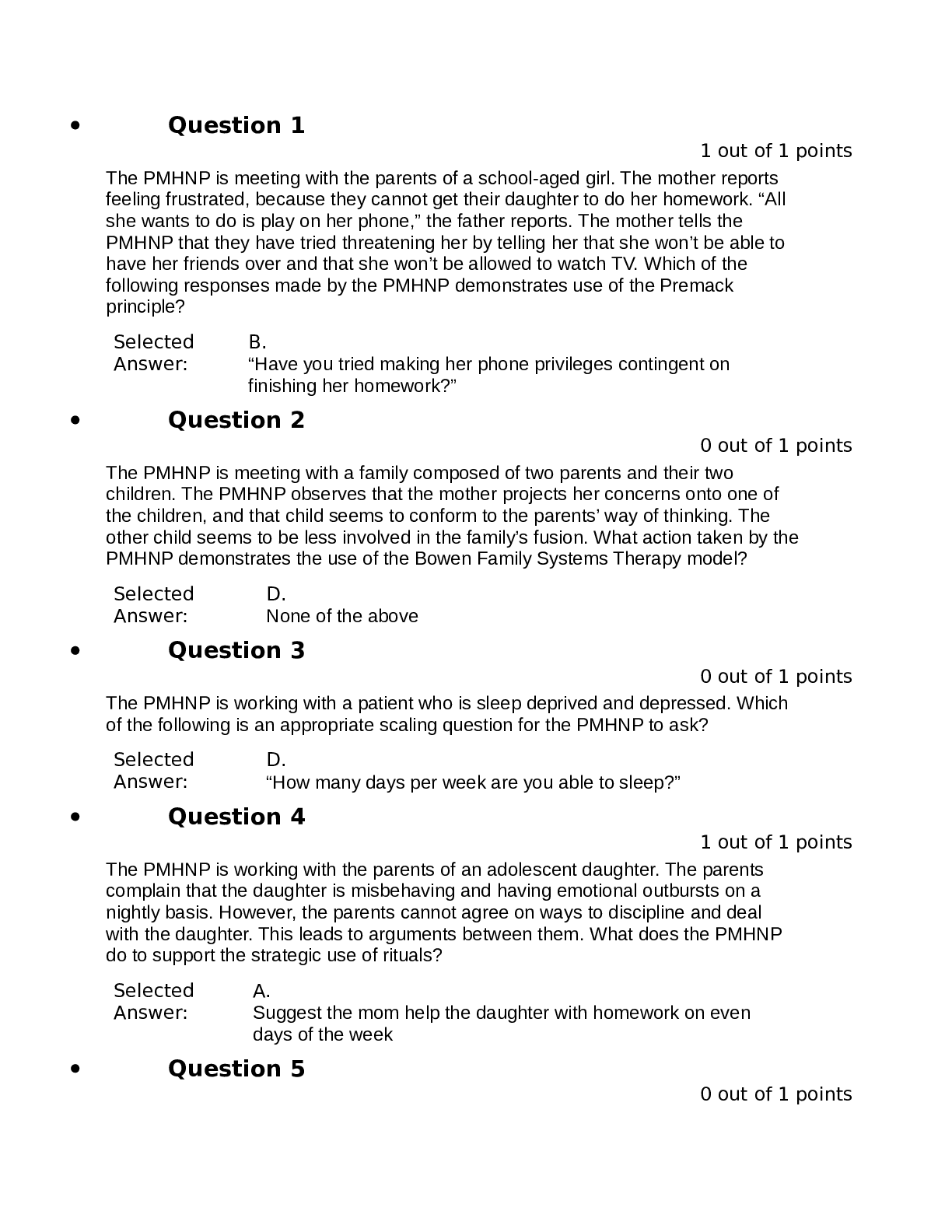
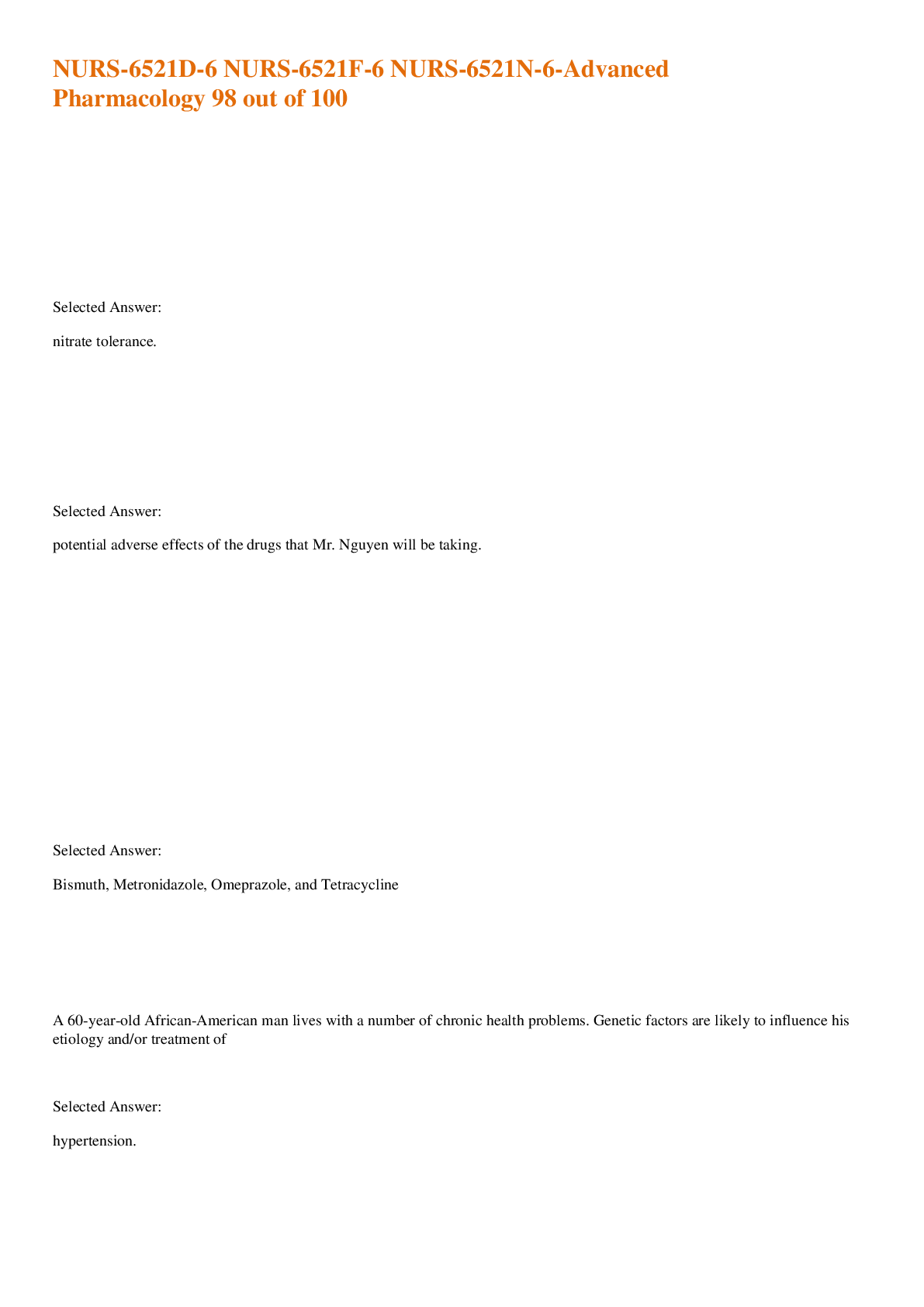
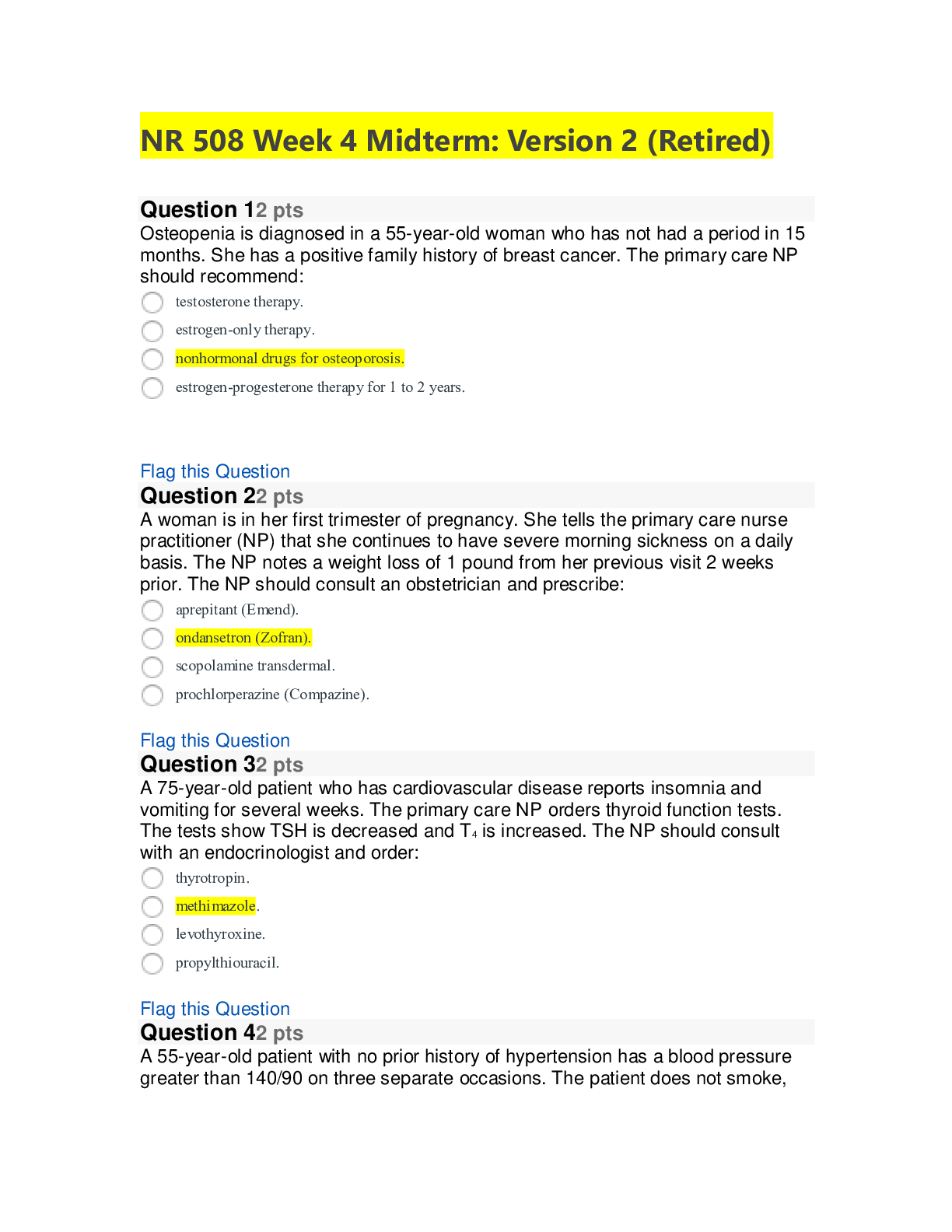







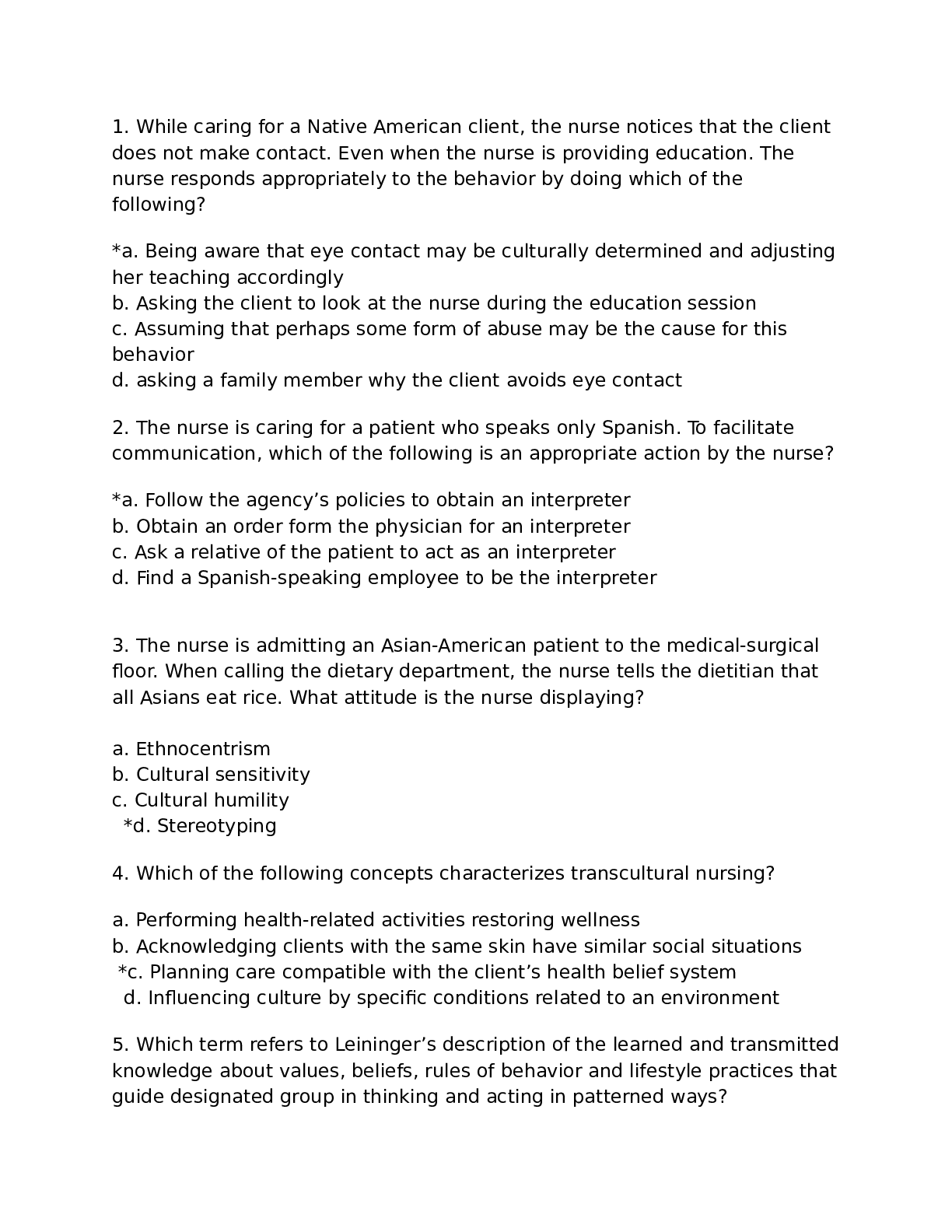

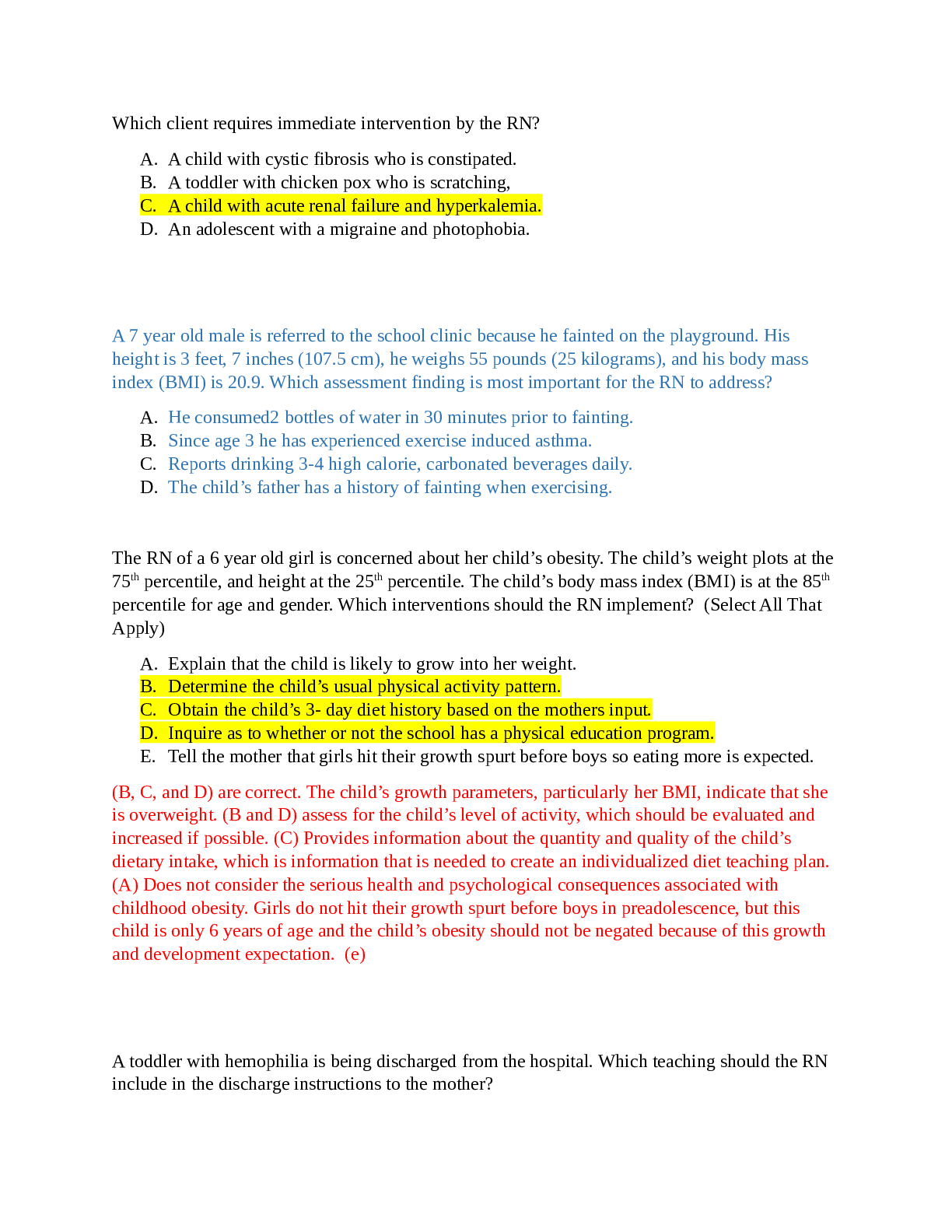
.png)
